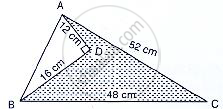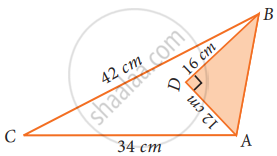Advertisements
Advertisements
Question
If the side of a rhombus is 10 cm and one diagonal is 16 cm, the area of the rhombus is 96 cm2.
Options
True
False
Solution
This statement is True.
Explanation:
To find the area of rhombus, we divide it into two triangles.
As all the sides of a rhombus are equal, we have for a triangle
a = 10, b = 10, c = 16
`s = (a + b + c)/2`
⇒ `s = (10 + 10 + 16)/2 = 36/2 = 18`.
Area (Δ) = `sqrt(s(s - a)(s - b)(s - c))`
⇒ Area (Δ) = `sqrt(18(18 - 10)(18 - 10)(18 - 16))`
⇒ Area (Δ) = `sqrt(18 xx 8 xx 8 xx 2)`
⇒ Area (Δ) = 48 cm2
As the sides of the other triangle are also same, so their areas will also be equal.
Area (Rhombus) = Area (Δ) + Area (Δ)
⇒ Area (Rhombus) = 48 + 48 = 96 cm2
APPEARS IN
RELATED QUESTIONS
Sides of a triangle are in the ratio of 12 : 17 : 25 and its perimeter is 540 cm. Find its area.
Find the area of the shaded region in the given figure.

The adjacent sides of a parallelogram ABCD measure 34 cm and 20 cm, and the diagonal AC measures 42 cm. Find the area of the parallelogram.
Find the area of a triangle whose sides are 3 cm, 4 cm and 5 cm respectively.
The area of a triangle is 5 sq. units. Two of its vertices are (2, 1) and (3, −2). The third vertex is (x, y) where y = x + 3. Find the coordinates of the third vertex.
The perimeter of a triangular plot is 600 m. If the sides are in the ratio 5 : 12 : 13, then find the area of the plot
Find the area of an equilateral triangle whose perimeter is 180 cm
Find the area of the unshaded region
The perimeter of an isosceles triangle is 32 cm. The ratio of the equal side to its base is 3 : 2. Find the area of the triangle.
A field is in the shape of a trapezium having parallel sides 90 m and 30 m. These sides meet the third side at right angles. The length of the fourth side is 100 m. If it costs Rs 4 to plough 1 m2 of the field, find the total cost of ploughing the field.
